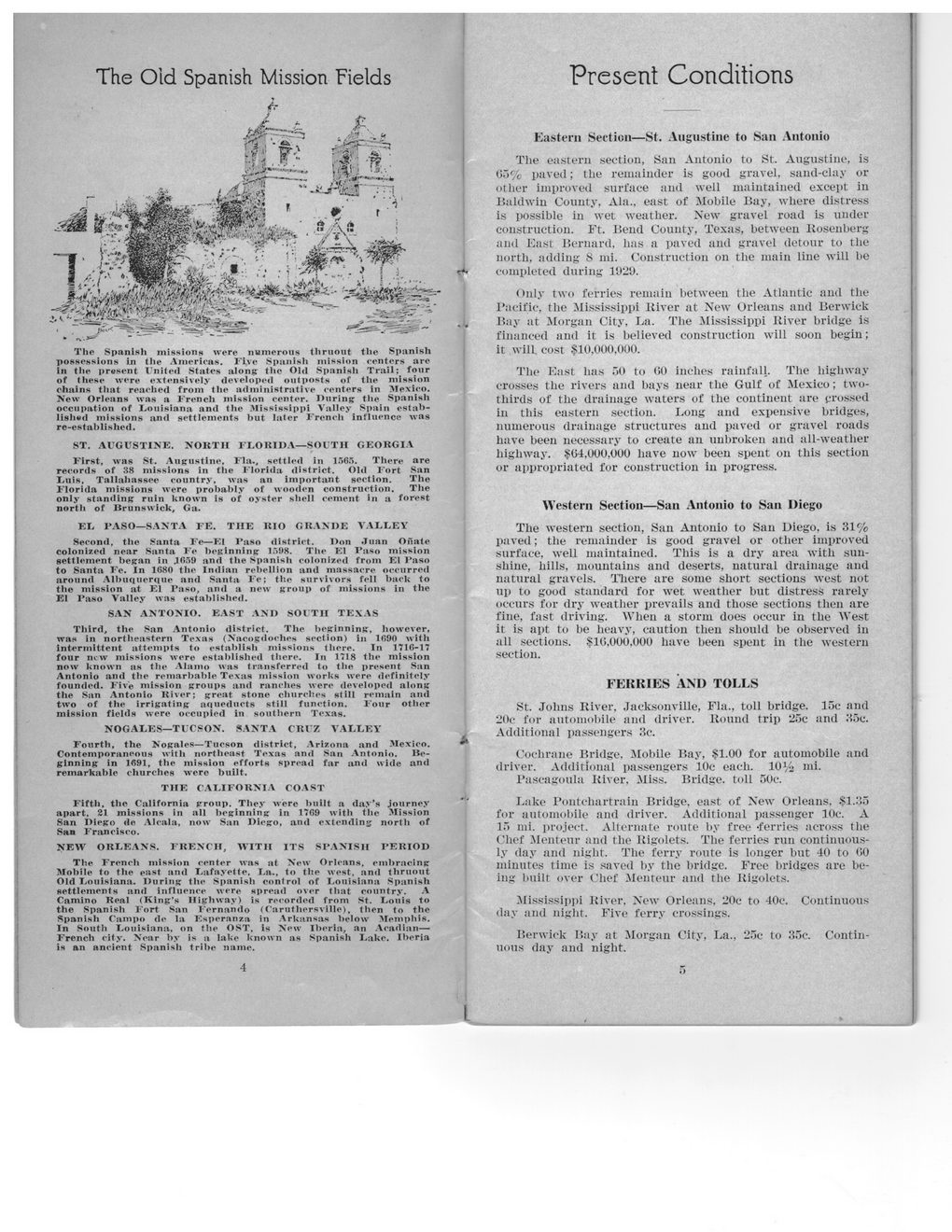This text was obtained via automated optical character recognition.
It has not been edited and may therefore contain several errors.
The Old Spanish Mission Fields Present Conditions f" The Spanish missions were numerous thruout the Spanish possessions in (lie Americas. Five Spanish mission centers are in the present United States along the Old Spanish Trail four of these were extensively developed outposts of the mission chains that reached from the administrative centers in Mexico. New Orleans was a French mission center. During: the Spanish occupation of Louisiana and the Mississippi Valley Spain established missions and settlements but later French influence was re-established. ST. AUGUSTINE. NORTH FLORIDA—SOUTH GEORGIA First, was St. Augustine, Fla., settled in 15(55. There are records of 38 missions in tlie Florida district. Old Fort San Luis. Tallahassee country, was an important section. The Florida missions were probably of wooden construction. The only standing ruin known is of oyster shell cement in a forest north of Itrunswick, Ga. EL PASO—SANTA FE. THE RIO GRANDE VALLEY Second, the Santa Fe—El Faso district. Don .Tuan Ofiate colonized near Santa Fe beginning 151)8. Tlie El Faso mission settlement began in ,3659 and the Spanish colonized from El Paso to Santa Fe. In 1080 the Indian rebellion and massacre occurred around Albuquerque and Santa Fe; the survivors fell back to the mission at El Paso, and a new group of missions in the E! Paso Valley was established. SAN ANTONIO. EAST AND SOUTH TEXAS Third, the San Antonio district. The beginning, however, was in northeastern Texas (Nacogdoches section) in 1090 with intermittent attempts to establish missions there. In 1710-17 four new missions were established there. In 1*18 the mission now known as the Alamo was transferred to the present San Antonio and the remarbable Texas mission works were definitely founded. Five mission groups and ranches were developed along the San Antonio River; great stone churches still remain anil two of the irrigating aqueducts still function. lour other mission fielils were occupied in southern Texas. NOGALES—TUCSON. SANTA CRUZ VALLEY Fourth, the Nogales—Tucson district, Arizona and Mexico. Contemporaneous with northeast Texas and San Antonio. Re-ginning in lf>91, the mission efforts spread far and wide and remarkable churches were built. THE CALIFORNIA COAST Fifth, the California group. They were built a day’s journey apart. 21 missions in all beginning in 1709 with the Mission San Diego de Alcala, now San Diego, and extending north of San Francisco. NEW ORLEANS. FRENCH, WITH ITS SPANISH PERIOD The French mission center was at New Orleans, embracing Mobile to the east and Lafayette, La., to the west, and thruout Old Louisiana. During the Spanish control of Louisiana Spanish settlements and influence were spread over that country. A Camino Real (King’s Highway) is recorded from St. Louis to the Spanish Fort San Fernando (Carutliersville), then to the Spanish Campo de la Esperanza in Arkansas below Memphis. In South Louisiana, on the OST, is New Iberia, an Acadian— French city. Near by is a lake known as Spanish Lake, Iberia is an ancient Spanish tribe name. Kastern Section—St. Augustine to San Antonio The eastern section, San Antonio to St. Augustine, is 05c/c paved; the remainder is good gravel, sand-clay or other improved surface and well maintained except in Baldwin County, Ala., east of Mobile -Buy, where distress is possible in wet weather. New gravel road is under construction. Ft. Bend County, Texas, between Rosenberg and East Bernard. has a paved and gravel detour to the north, adding S mi. Construction on the main line will be completed during 11)21). Only two ferries remain between the Atlantic and the Pacific, the Mississippi River at New Orleans and Berwick Hay at Morgan City, La. The Mississippi River bridge is financed and it is believed construction will soon begin; it will cost .fl0.000.000. The East has .">0 to 00 inches rainfall. The highway crosses the rivers and bays near the Gulf of Mexico; two-tliirds of the drainage waters of the continent are crossed in this eastern section. Long and expensive bridges, numerous drainage structures and paved or gravel roads have been necessary to create an unbroken and all-weather highway. ¥04.000.000 have now been spent on this section or appropriated for construction in progress. Western Section—San Antonio to San Diego The western section, San Antonio to San Diego, is 31% paved; the remainder is good gravel or other improved surface, well maintained. This is a dry area with sunshine, hills, mountains and deserts, natural drainage and natural gravels. There are some short sections west not up to good standard for wet weather but distress rarely occurs for dry weather prevails and those sections then are fine, fast driving. When a storm does occur in the West it is apt to be heavy, caution then should be observed in all sections, Jflli.000.000 have been spent in the western section. FEKKIES ANI) TOLLS St. Johns River. Jacksonville, Fla., toll bridge. 15c and 20c for automobile and driver. Round trip 25c and 35c. , Additional passengers 3c. Cochrane Bridge. Mobile Iia.v, $1.00 for automobile and driver. Additional passengers 10c each. 10*2 mi. Pascagoula River. Miss. Bridge, toll 50c. Lake Pontchartrain Bridge, east of New Orleans. SI.35 for automobile and driver. Additional passenger 10c. A 15 mi. project. Alternate route by free 'ferries across the Chef Menteur and the Rigolets. The ferries run continuously day and night. The ferry route is longer but 40 to 00 minutes time is saved by the bridge. Free bridges are being I milt over Chef Menteur and the Rigolets. Mississippi River. New Orleans. 20c to 40c. Continuous day and night. Five ferry crossings. Berwick Iia.v at Morgan City, La., 25c to 35c. Continuous day and night. 4

Old Spanish Trail Document (003)